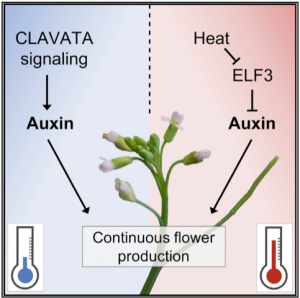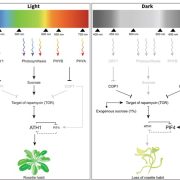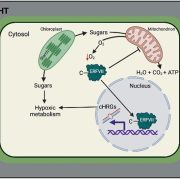CLAVATA signaling ensures reproductive development in plants across thermal environments (Curr. Biol.)
 Plant reproduction and development requires robust signaling pathways that integrate environmental queues such as temperature. In Arabidopsis, the formation of flower primordia from the inflorescence meristem (IM) depends on the proliferation/ differentiation balance and is regulated by auxin and the conserved CLAVATA3 (CLV3) signaling pathway. CLV3 acts through many receptors to negatively regulate the WUSCHEL transcription factor, and thus proliferation, in the IM. Among these receptors, the CLAVATA2/CORYNE (CLV2/CRN) complex acts as a negative regulator of cell proliferation in the IM independently of other CLV3 receptors, however, recent work has shed light on a new function. Through combinatorial null mutant analyses, Jones et al. showed that CLV2/CRN contributes to flower primordia outgrowth in cooperation with the CLAVATA3 INSENSITIVE RECEPTOR KINASE1/2/3/4 family of co-receptors and temperature-dependent auxin signaling. Flower outgrowth defects observed in clv2/crn plants are suppressed at high temperatures. Mutants of EARLY FLOWERING 3 (ELF3), a thermomorphogenesis transcriptional repressor, introgressed in the crn background (crn elf3 double mutant) also suppressed the outgrowth defects, thus linking CLAVATA signaling to thermomorphogenetic pathways. RNA-seq analysis of crn plants revealed decreased expression of YUCCA auxin biosynthetic genes, whereas ectopic YUC1 expression in developing flower primordia of crn plants suppresses flower outgrowth defects at high temperatures but not as efficiently in cold/ambient temperatures, suggesting that YUCCA genes contribute to heat-induced suppression. This paper highlights a new buffering mechanism to ensure sustained flower production across thermal conditions, a signaling pathway that could be deployed to help mitigate the impacts of heat due to global warming. (Summary by Jesus Leon @jesussaur) Curr. Biol. 10.1016/j.cub.2020.10.008
Plant reproduction and development requires robust signaling pathways that integrate environmental queues such as temperature. In Arabidopsis, the formation of flower primordia from the inflorescence meristem (IM) depends on the proliferation/ differentiation balance and is regulated by auxin and the conserved CLAVATA3 (CLV3) signaling pathway. CLV3 acts through many receptors to negatively regulate the WUSCHEL transcription factor, and thus proliferation, in the IM. Among these receptors, the CLAVATA2/CORYNE (CLV2/CRN) complex acts as a negative regulator of cell proliferation in the IM independently of other CLV3 receptors, however, recent work has shed light on a new function. Through combinatorial null mutant analyses, Jones et al. showed that CLV2/CRN contributes to flower primordia outgrowth in cooperation with the CLAVATA3 INSENSITIVE RECEPTOR KINASE1/2/3/4 family of co-receptors and temperature-dependent auxin signaling. Flower outgrowth defects observed in clv2/crn plants are suppressed at high temperatures. Mutants of EARLY FLOWERING 3 (ELF3), a thermomorphogenesis transcriptional repressor, introgressed in the crn background (crn elf3 double mutant) also suppressed the outgrowth defects, thus linking CLAVATA signaling to thermomorphogenetic pathways. RNA-seq analysis of crn plants revealed decreased expression of YUCCA auxin biosynthetic genes, whereas ectopic YUC1 expression in developing flower primordia of crn plants suppresses flower outgrowth defects at high temperatures but not as efficiently in cold/ambient temperatures, suggesting that YUCCA genes contribute to heat-induced suppression. This paper highlights a new buffering mechanism to ensure sustained flower production across thermal conditions, a signaling pathway that could be deployed to help mitigate the impacts of heat due to global warming. (Summary by Jesus Leon @jesussaur) Curr. Biol. 10.1016/j.cub.2020.10.008









